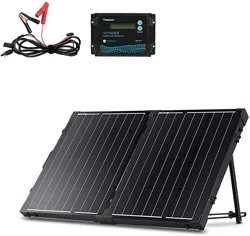Loading ...
Loading ...
Loading ...

04
Four Charging Stages
Equalization: Is carried out every 28 days of the month. It is intentional overcharging of the
battery for a controlled period of time. Certain types of batteries benefit from periodic equalizing
charge, which can stir the electrolyte, balance battery voltage and complete chemical reaction.
Equalizing charge increases the battery voltage, higher than the standard complement voltage,
which gasifies the battery electrolyte.
Bulk Charge: This algorithm is used for day to day charging. It uses 100% of available solar
power to recharge the battery and is equivalent to constant current.
Float Charge: After Boost Charge, the controller will reduce the battery voltage to a float
voltage set point. Once the battery is fully charged, there will be no more chemical reactions and
all the charge current would turn into heat or gas. Because of this, the charge controller will
reduce the voltage charge to smaller quantity, while lightly The Voyager charge controller has a
4-stage battery charging algorithm for a rapid, efficient, and safe battery charging. They include:
Bulk Charge, Boost Charge, Float Charge, and Equalization.charging the battery. The purpose
for this is to offset the power consumption while maintaining a full battery storage capacity. In the
event that a load drawn from the battery exceeds the charge current, the controller will no longer
be able to maintain the battery to a Float set point and the controller will end the float charge
stage and refer back to bulk charging.
Boost Charge: When the battery has charged to the Boost voltage set-point, it undergoes an
absorption stage which is equivalent to constant voltage regulation to prevent heating and
excessive gassing in the battery. The default time for this is 120 minutes for the Voyager.
Once equalization is active in the battery charging, it will not exit this stage unless
there is adequate charging current from the solar panel. There should be NO load
on the batteries when in equalization charging stage.
Over-charging and excessive gas precipitation may damage the battery plates
and activate material shedding on them. Too high of equalizing charge or for too
long may cause damage. Please carefully review the specific requirements of the
battery used in the system.
Equalization may increase battery voltage to a level damaging to sensitive DC
loads. Ensure that all load allowable input voltages are greater than the equalizing
charging set point volta.
WARNUNG
WARNUNG
WARNUNG
TIME
NIGHT
BOOST
EQUALIZE
FLOAT
NIGHT
BULK
CHARGE
VOLTAGE
Loading ...
Loading ...
Loading ...
